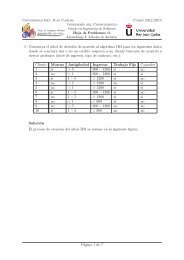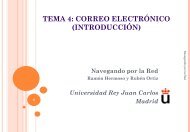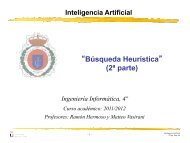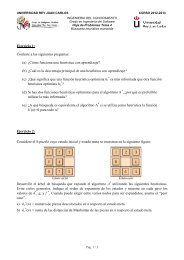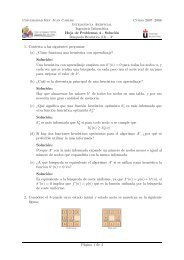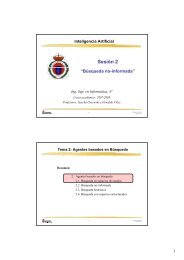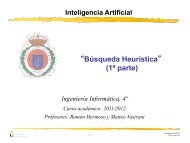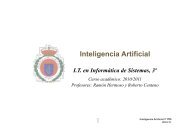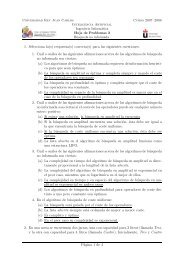GLIRS-II - Grupo de Inteligencia Artificial - Universidad Rey Juan ...
GLIRS-II - Grupo de Inteligencia Artificial - Universidad Rey Juan ...
GLIRS-II - Grupo de Inteligencia Artificial - Universidad Rey Juan ...
You also want an ePaper? Increase the reach of your titles
YUMPU automatically turns print PDFs into web optimized ePapers that Google loves.
TIC2003-06293<br />
will be necessary to see how to annotate UML and how can be exten<strong>de</strong>d the different UML<br />
diagrams in or<strong>de</strong>r to correctly construct the performance mo<strong>de</strong>ls and then to execute them.<br />
3. Another approach to build the tool is <strong>de</strong>rived from MASCOT as <strong>de</strong>sign method for real-time<br />
systems. This requires to complete the taxonomy of data interchange protocols to collect all<br />
the aspects related to the performance mo<strong>de</strong>lling and then to set up the tool allowing <strong>de</strong>riving<br />
queuing network mo<strong>de</strong>ls.<br />
1.2 Modified goals<br />
Due to several reasons (several members of the research team left the university, discovering new<br />
aspects interesting to be researched, etc.), the current goals of the project are:<br />
1. The goal 3 has been worked out but instead of creating a tool for <strong>de</strong>riving performance<br />
mo<strong>de</strong>ls, the annotations of a MASCOT <strong>de</strong>sign have been standardised and a simulation<br />
process has been set up directly using the <strong>de</strong>sign <strong>de</strong>scription together with the annotations to<br />
obtain the <strong>de</strong>sired performance estimations.<br />
2. The goal 1 has been modified in or<strong>de</strong>r to <strong>de</strong>velop PMIF, Performance Mo<strong>de</strong>l Interchange<br />
Format, a mechanism whereby system mo<strong>de</strong>l information may be transferred among<br />
performance mo<strong>de</strong>lling tools. Also it has been <strong>de</strong>monstrated how Web services can be used to<br />
facilitate the use of mo<strong>de</strong>lling tools that can interface with the PMIF. Indirectly, it also<br />
inclu<strong>de</strong>s part of the goal 1 because one type of the performance mo<strong>de</strong>ls consi<strong>de</strong>red is the one<br />
based on UML mainly as input to obtain some type of performance mo<strong>de</strong>l able to be<br />
computed to obtain performance results.<br />
3. A new topic that has been inclu<strong>de</strong>d in the project goals is the performance assessment of<br />
ambient intelligence systems through ontology engineering. Thus, firstly it has been necessary<br />
to find appropriate <strong>de</strong>scription methods for distributed intelligent applications. Derived from<br />
the system characterization, typical software performance engineering techniques are based on<br />
the augmented <strong>de</strong>scription of the mo<strong>de</strong>l regarding performance annotations. However, these<br />
annotations are only related with the syntactical view of the software architecture. In the next<br />
generation of performance assessment tools for ambient intelligent systems, the <strong>de</strong>scription of<br />
the system has to be able of reasoning and acquiring knowledge about performance. Having<br />
an appropriate architectural <strong>de</strong>scription including performance aspects, any possible <strong>de</strong>sign<br />
options for intelligent distributed applications can be evaluated according to their performance<br />
impact.<br />
2. Main results related to each goal<br />
2.1 MASCOT performance mo<strong>de</strong>ls (MASCOTime)<br />
Soft real-time systems differ from traditional software systems in that they have a dual notion of<br />
correctness. That is, in addition to producing the correct output, soft real-time systems must<br />
produce it in a timely manner.<br />
One of the most usual approaches to software engineering is based on the concept of a system as a<br />
set of interacting components. In or<strong>de</strong>r to characterize the interaction between the components is<br />
also necessary to express a protocol representing the timing constraints on the interaction and to its<br />
support by an explicit interconnection in the future implemented system.<br />
MASCOT (Modular Approach to Software Construction Operation and Test) is a <strong>de</strong>sign and<br />
implementation method for real-time software <strong>de</strong>velopment and brings together a co-ordinated set<br />
of techniques for <strong>de</strong>aling with the <strong>de</strong>sign, construction (system building), operation (run-time<br />
execution) and testing software, as its acronym wants to <strong>de</strong>pict [1]. At the heart of MASCOT there<br />
22



